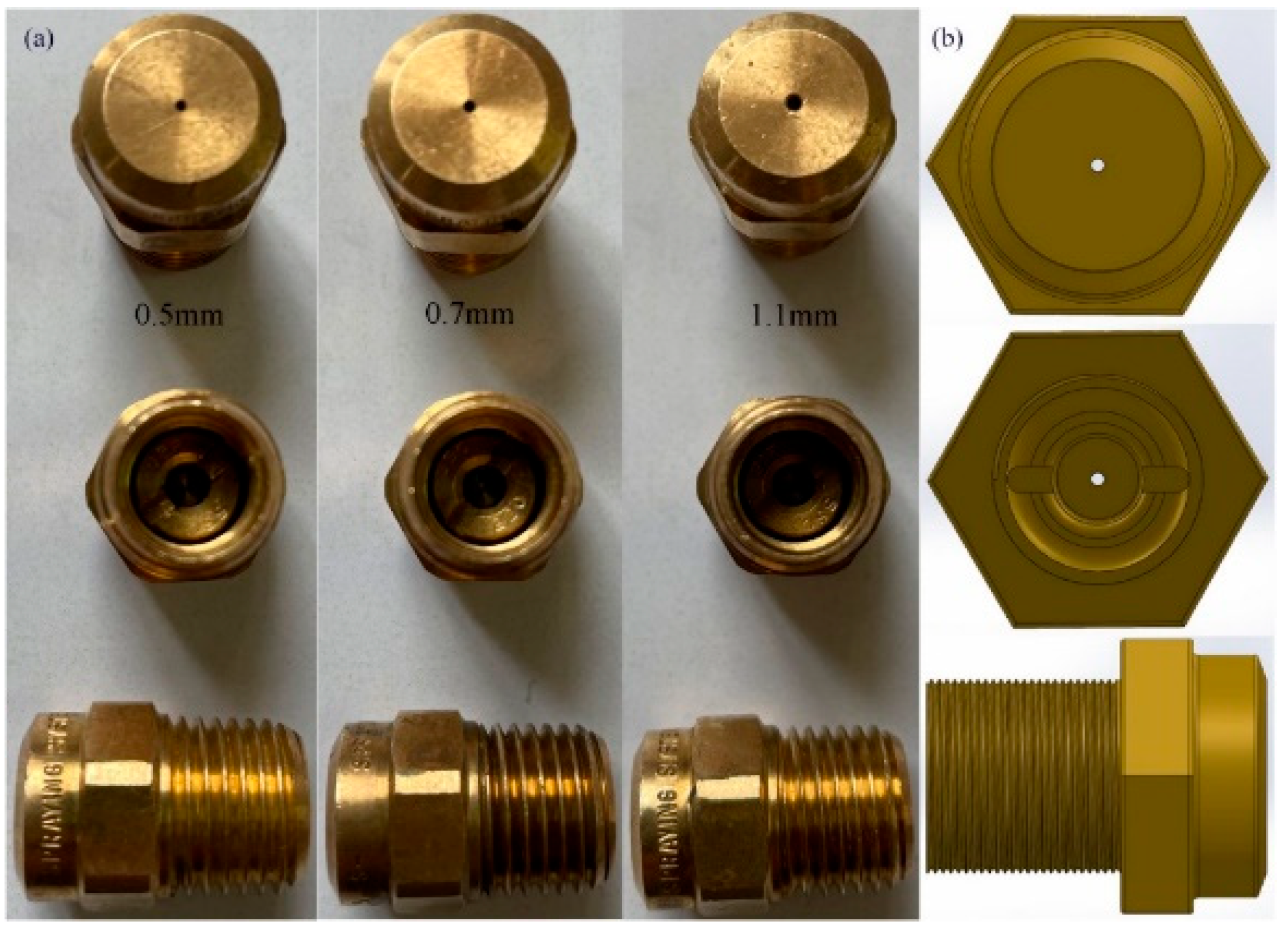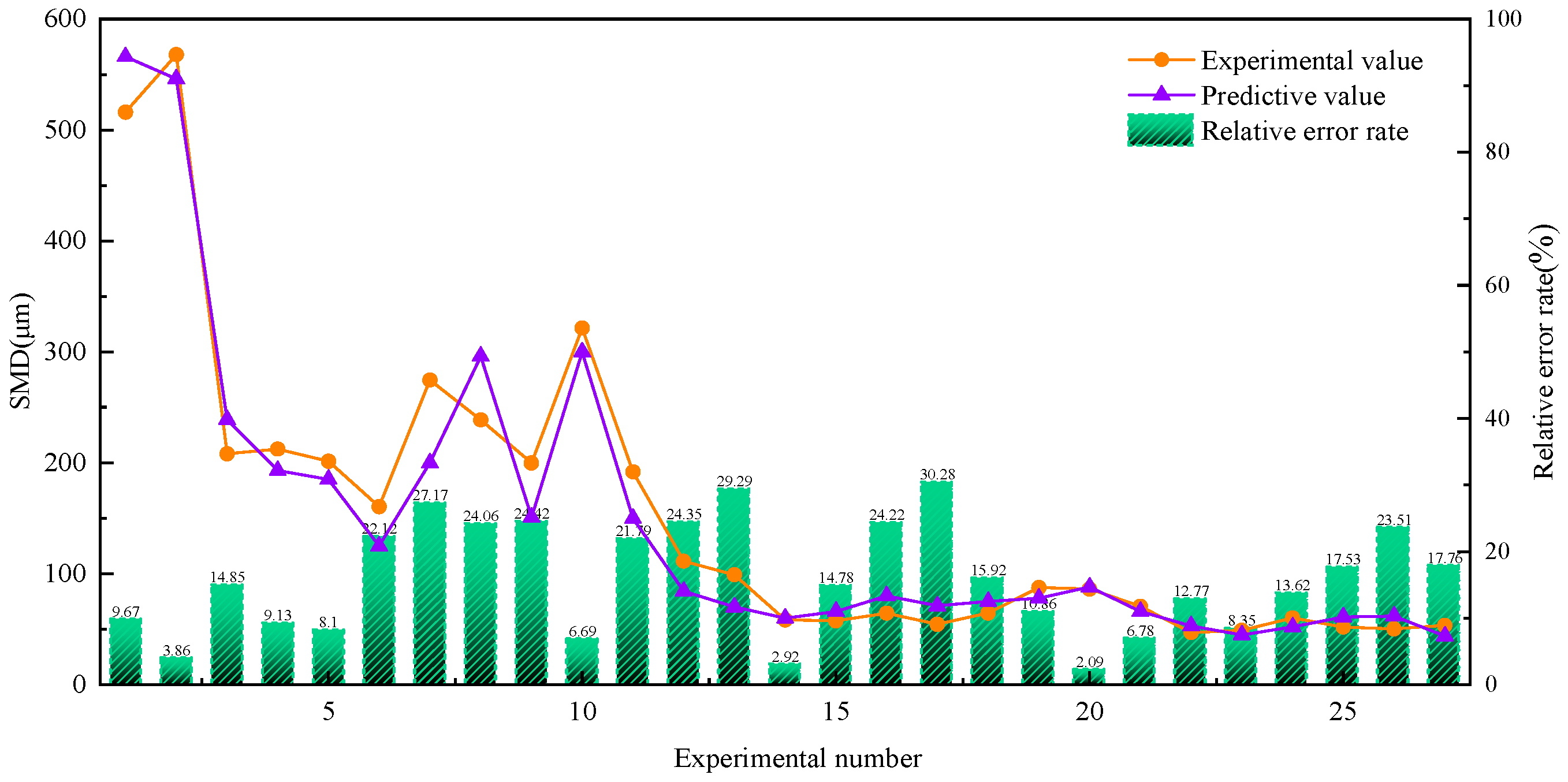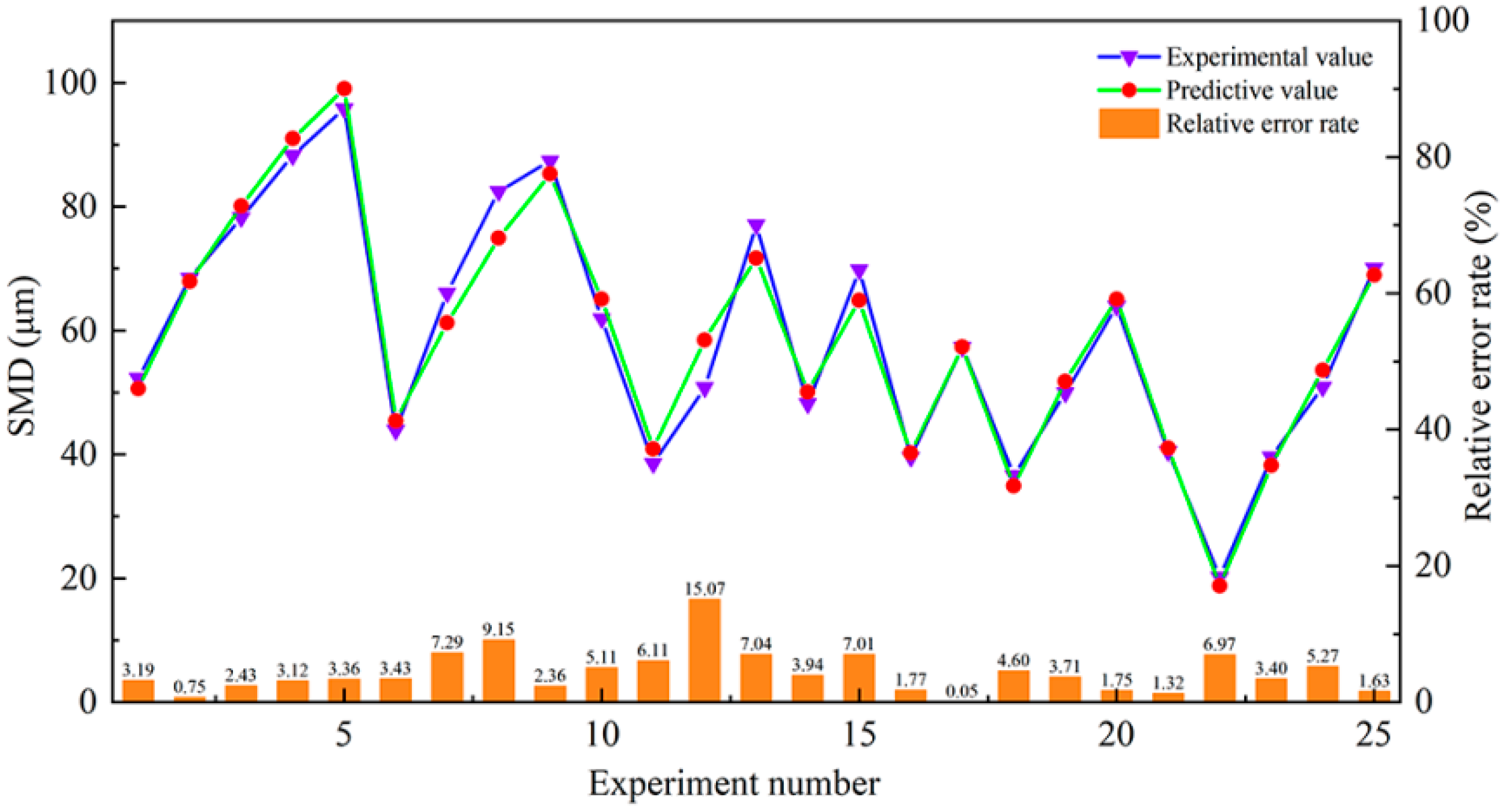A Mathematical Model for Predicting the Droplet Size of Micro-Fog Nozzle with Circular-Hole Rotating Core Based on Orthogonal Design
Abstract
1. Introduction
2. Experimental System and Scheme
2.1. Experimental System
2.2. Experimental Scheme
3. Experimental Results and Analysis
3.1. Droplet Size Parameter Analysis
3.2. Droplet Size Distribution Analysis
3.3. Droplet Size Analysis with Orthogonal Experiment
4. Regression Analysis and Model Verification
4.1. Regression Analysis
4.2. Model Verification
4.3. Nozzle Comparison
5. Conclusions
- (1)
- In this paper, the mathematical model for predicting the SMD of the circular-hole rotating core micro-fog nozzle was constructed and included the axial distance, outlet diameter, and water supply pressure. The droplet size decreased with the increase of the axial distance and water supply pressure. As the outlet diameter increased, the droplet size decreased first and then increased.
- (2)
- Through the analysis of the range method, it was concluded that among the three factors, the axial distance had the greatest influence on the droplet size, followed by the outlet diameter; the water supply pressure had the least influence on it.
- (3)
- According to Figure 5, the smaller the droplet size of the nozzle, the higher the ability to remove dust. In order to obtain the droplet size with the best dust removal effect, the optimal level of the factors was an outlet diameter of 1.1 mm, a water supply pressure of 1 MPa, and an axial distance of 70 cm.
- (4)
- The predicted value of the mathematical model for predicting the SMD of the circular-hole rotating core micro-fog nozzle was in basic agreement with the experimental value, and the average relative error was 16.11%, which was less than 20%.
Author Contributions
Funding
Institutional Review Board Statement
Informed Consent Statement
Acknowledgments
Conflicts of Interest
References
- Cheng, W.M.; Zhou, G.; Chen, L.J. Research progress and prospect of dust control theory and technology in China’s coal mines in the past 20 years. Coal Sci. Technol. 2020, 48, 1–20. [Google Scholar]
- Bi, M.C.; Yao, J.; Yu, M. Characteristic features of dust blasts in the MOTAS/carbon black mixed system. J. Saf. Environ. 2017, 17, 169–173. [Google Scholar]
- Yuan, L. Scientific conception of coal mine dust control and occupational safety. J. China Coal Soc. 2020, 45, 1–7. [Google Scholar]
- Huang, Z.; Huang, Y.; Yang, Z.J.; Zhang, J.; Zhang, Y.H.; Gao, Y.K.; Shao, Z.L.; Zhang, L.H. Study on the physicochemical characteristics and dust suppression performance of new type chemical dust suppressant for copper mine pavement. Environ. Sci. Pollut. Res. 2021, 28, 59640–59651. [Google Scholar] [CrossRef]
- Ma, X.Y.; Xiao, Z.H.; He, L.Z.; Cao, Y.J.; Liu, J.S. Comparison of chemical characteristics of PM2.5 during two winters in Xiangtan City in south central China. J. Atmos. Chem. 2020, 77, 169–183. [Google Scholar] [CrossRef]
- Ma, X.Y.; Xiao, Z.H.; He, L.Z.; Shi, Z.B.; Cao, Y.J.; Tian, Z.; Tuan, V.; Liu, J.S. Chemical Composition and Source Apportionment of PM2.5 in Urban Areas of Xiangtan, Central South China. Int. J. Environ. Res. Public Health 2019, 16, 539. [Google Scholar] [CrossRef]
- Yang, Z.C. Modeling and forecasting daily movement of ambient air mean PM2.5 concentration based on the elliptic orbit model with weekly quasi-periodic extension: A case study. Environ. Sci. Pollut. Res. 2014, 21, 9959–9972. [Google Scholar] [CrossRef]
- Liu, Y.L.; Shi, S.L.; Wang, G.X.; Li, H.; Wang, T. Micro-particles stabilized aqueous foam for coal spontaneous combustion control and its flow characteristics. Process Saf. Environ. Prot. 2020, 139, 262–272. [Google Scholar] [CrossRef]
- Jia, X.L.; Wu, J.K.; Lian, C.J.; Wang, J.J.; Rao, J.L.; Feng, R.J.; Chen, Y. Investigating the effect of coal particle size on spontaneous combustion and oxidation characteristics of coal. Environ. Sci. Pollut. Res. 2022, 29, 16113–16122. [Google Scholar] [CrossRef]
- Huang, H.; Zhang, L.H.; Yang, Z.J.; Zhang, J.; Gao, Y.K.; Zhang, Y.H. Preparation and properties of a rock dust suppressant for a copper mine. Atmos. Pollut. Res. 2019, 10, 2010–2017. [Google Scholar] [CrossRef]
- Hu, J.H.; Li, N.P.; Zou, S.H.; Hiroshi, Y.; Yanagi, U.; Yu, C.W.; Qu, H.D. Indoor environmental conditions in schoolchildren’s homes in central-south China. Indoor Built Environ. 2020, 29, 956–971. [Google Scholar] [CrossRef]
- Zhang, Z.Y.; Yin, W.; Wang, T.W.; O’Donovan, A. Effect of cross-ventilation channel in classrooms with interior corridor estimated by computational fluid dynamics. Indoor Built Environ. 2022, 31, 1047–1065. [Google Scholar] [CrossRef]
- Wang, P.F.; Han, H.; Tian, C.; Liu, R.H.; Jiang, Y.D. Experimental study on dust reduction via spraying using surfactant solution. Atmos. Pollut. Res. 2020, 11, 32–42. [Google Scholar] [CrossRef]
- Wang, P.F.; Shi, Y.J.; Zhang, L.Y.; Li, Y.J. Effect of structural parameters on atomization characteristics and dust reduction performance of internal-mixing air-assisted atomizer nozzle. Process Saf. Environ. Prot. 2019, 128, 316–328. [Google Scholar] [CrossRef]
- Wang, P.F.; Tan, X.H.; Zhang, L.Y.; Li, Y.J.; Liu, R.H. Influence of particle diameter on the wettability of coal dust and the dust suppression efficiency via spraying. Process Saf. Environ. Prot. 2019, 132, 189–199. [Google Scholar] [CrossRef]
- Wang, P.F.; Han, H.; Liu, R.H.; Gao, R.Z.; Wu, G.G. Effect of outlet diameter on atomization characteristics and dust reduction performance of X-swirl pressure nozzle. Process Saf. Environ. Prot. 2020, 137, 340–351. [Google Scholar] [CrossRef]
- Wang, P.F.; Jiang, Y.D.; Liu, R.H.; Liu, L.M.; He, Y.C. Experimental Study on the Improvement of Wetting Performance of OP-10 Solution by Inorganic Salt Additives. Atmos. Pollut. Res. 2020, 11, 153–161. [Google Scholar] [CrossRef]
- Wang, P.F.; Tian, C.; Liu, R.H.; Wang, J. Mathematical model for multivariate nonlinear prediction of SMD of X-type swirl pressure nozzles. Process Saf. Environ. Prot. 2019, 125, 228–237. [Google Scholar] [CrossRef]
- Nie, W.; Liu, Y.H.; Cheng, W.M.; Zhou, G.; Ma, X. Dust removal technology of eject spraying between hydraulic supports on fully mechanized mining face. J. Cent. South Univ. (Sci. Technol.) 2015, 46, 4384–4390. [Google Scholar]
- Gui, Z. Experimental Study on the High Efficiency Spray and Dust Removal in Coal Mine; Hunan University of Science and Technology: Xiangtan, China, 2017. [Google Scholar]
- Ma, X. Research on the Spray Atomization Law and Dust Reduction Technology in Fully Mechannized Coaling Face; Shandong University of Science and Technology: Qingdao, China, 2017. [Google Scholar]
- Cheng, W.M.; Liu, G.M.; Chen, L.J. Research Progress of Mine Shotcrete Dust Control Technology. Saf. Coal Mines 2020, 51, 87–97. [Google Scholar]
- Wang, P.F.; Liu, R.H.; Wang, H.Q. Atomization characteristics of air-water spray in underground coal mine. J. China Coal Soc. 2017, 42, 1213–1220. [Google Scholar]
- Zhang, Y.; Liu, S.Y.; Liu, Q.; Wang, X.; Jiang, Z.L.; Wei, J.F. The Role of Debris Cover in Catchment Runoff: A Case Study of the Hailuogou Catchment, South-Eastern Tibetan Plateau. Water 2019, 11, 2601. [Google Scholar] [CrossRef]
- You, B.; Xu, J.X.; Shi, S.L.; Liu, H.Q.; Lu, Y.; Liang, X.Y. Treatment of Coal Mine Sewage by Catalytic Supercritical Water Oxidation. Fresenius Environ. Bull. 2020, 29, 497–502. [Google Scholar]
- Poozesh, S.; Akafuah, N.K.; Campbell, H.R.; Bashiri, F.; Saito, K. Experimental and mathematical tools to predict droplet size and velocity distribution for a two-fluid nozzle. Campbell H R. Fluids 2020, 5, 231. [Google Scholar] [CrossRef]
- Obenauf, D.G.; Sojka, P.E. Theoretical deformation modeling and drop size prediction in the multimode breakup regime. Phys. Fluids 2021, 33, 092113. [Google Scholar] [CrossRef]
- Renaudo, C.A.; Yommi, A.; Slaboch, G.; Bucalá, V.; Bertin, D.E. Prediction of droplet size distributions from a pre-orifice nozzle using the Maximum Entropy Principle. Chem. Eng. Res. Des. 2022, 185, 198–209. [Google Scholar] [CrossRef]
- Lachin, K.; Niane, M.; Person, M.; Mazet, J.; Delaplace, G.; Turchiuli, C. Prediction of droplets characteristic diameters and polydispersity index induced by a bifluid spraying nozzle by the means of dimensional analysis. Chem. Eng. Sci. 2023, 265, 118187. [Google Scholar] [CrossRef]
- Liu, M.L.; Zhang, X. Research on Spray Characteristics of Pressure and Fine Mist Nozzles. J. Tongji Univ. (Nat. Sci.) 2005, 33, 1677–1679+1684. [Google Scholar]
- Liang, P.; Zhou, H.P. Research on Prediction of Droplet Size Based on Grey Theory. For. Mach. Woodwork. Equip. 2008, 8, 54–56. [Google Scholar]
- Guo, J.H.; Tan, X.S.; Bi, R.S. Model prediction and experiment study on spray droplet size distribution of pressure swirl nozzle. Chem. Ind. Eng. Prog. 2012, 31, 528–532. [Google Scholar]
- Qu, R.J.; Ru, Y.; Lu, F. Experiment on speed and atomization performance of air rotary cage nozzle. J. Jiangsu Univ. (Nat. Sci. Ed.) 2020, 41, 452–458. [Google Scholar]
- Ni, J.S.; Ru, Y.; Wang, J.S. Experimental Study on Prediction of Droplet Drift. J. Agric. Mech. Res. 2020, 42, 152–157. [Google Scholar]
- Liu, R.H.; Wu, G.G.; Wang, P.F. Prediction model of mass median diameter of X-type swirl pressure nozzle. J. Saf. Environ. 2021, 21, 1467–1473. [Google Scholar]
- Li, S.L.; Wu, G.G.; Wang, P.F.; Cui, Y.; Tian, C.; Han, H. A Mathematical Model for Predicting the Sauter Mean Diameter of Liquid-Medium Ultrasonic Atomizing Nozzle Based on Orthogonal Design. Appl. Sci. 2021, 11, 11628. [Google Scholar] [CrossRef]







| Serial Number | S (cm) | D (mm) | P (MPa) |
|---|---|---|---|
| 1 | 30 | 0.5 | 1 |
| 2 | 50 | 0.7 | 2 |
| 3 | 70 | 1.1 | 3 |
| S/cm | D/mm | P/MPa | D50 | D[3,2] | D[4,3] | S/cm | D/mm | P/MPa | D50 | D[3,2] | D[4,3] |
|---|---|---|---|---|---|---|---|---|---|---|---|
| 30 | 0.5 | 1 | 681.3 | 516.1 | 677.2 | ||||||
| 0.5 | 2 | 681.5 | 567.9 | 681.0 | |||||||
| 0.5 | 3 | 674.6 | 208.1 | 580.3 | |||||||
| 0.7 | 1 | 668.4 | 212.4 | 534.2 | |||||||
| 0.7 | 2 | 668.8 | 201.3 | 536.2 | 70 | 0.5 | 1 | 110.2 | 87.5 | 155.5 | |
| 0.7 | 3 | 658.2 | 160.5 | 482.8 | 0.5 | 2 | 105.9 | 86.2 | 238.1 | ||
| 1.1 | 1 | 672.5 | 274.6 | 571.0 | 0.5 | 3 | 93.7 | 70.8 | 331.7 | ||
| 1.1 | 2 | 668.1 | 238.6 | 533.3 | 0.7 | 1 | 62.0 | 47.0 | 160.6 | ||
| 1.1 | 3 | 656.1 | 199.8 | 474.5 | 0.7 | 2 | 61.5 | 49.1 | 144.2 | ||
| 50 | 0.5 | 1 | 669.5 | 321.5 | 553.5 | 0.7 | 3 | 71.8 | 60.2 | 230.4 | |
| 0.5 | 2 | 544.8 | 191.8 | 468.0 | 1.1 | 1 | 68.2 | 51.9 | 77.3 | ||
| 0.5 | 3 | 296.0 | 111.3 | 349.8 | 1.1 | 2 | 64.7 | 50.2 | 72.9 | ||
| 0.7 | 1 | 139.1 | 99.0 | 333.8 | 1.1 | 3 | 71.9 | 53.5 | 101.4 | ||
| 0.7 | 2 | 80.3 | 58.3 | 152.2 | |||||||
| 0.7 | 3 | 71.4 | 57.5 | 192.1 | |||||||
| 1.1 | 1 | 95.0 | 64.4 | 153.0 | |||||||
| 1.1 | 2 | 81.2 | 54.5 | 90.4 | |||||||
| 1.1 | 3 | 84.9 | 64.7 | 165.4 | |||||||
| Serial Number | S/cm | D/mm | P/MPa | D50 | D[3,2] | D[4,3] |
|---|---|---|---|---|---|---|
| 1 | 30 | 0.5 | 1 | 681.3 | 516.1 | 677.2 |
| 2 | 30 | 0.7 | 3 | 658.2 | 160.5 | 482.8 |
| 3 | 30 | 1.1 | 2 | 668.1 | 238.6 | 533.3 |
| 4 | 50 | 0.5 | 3 | 296.0 | 111.3 | 349.8 |
| 5 | 50 | 0.7 | 2 | 80.3 | 58.3 | 152.2 |
| 6 | 50 | 1.1 | 1 | 98.0 | 64.4 | 153 |
| 7 | 70 | 0.5 | 2 | 105.9 | 86.2 | 238.1 |
| 8 | 70 | 0.7 | 1 | 62.0 | 47.0 | 160.6 |
| 9 | 70 | 1.1 | 3 | 71.9 | 53.5 | 101.4 |
| Variance Source | Freedom | F | p > F |
|---|---|---|---|
| Model | 10 | 41.253 | <0.001 |
| Error | 17 | ||
| Overall difference | 27 | R2 = 0.811 R2(revise) = 0.802 | |
Disclaimer/Publisher’s Note: The statements, opinions and data contained in all publications are solely those of the individual author(s) and contributor(s) and not of MDPI and/or the editor(s). MDPI and/or the editor(s) disclaim responsibility for any injury to people or property resulting from any ideas, methods, instructions or products referred to in the content. |
© 2023 by the authors. Licensee MDPI, Basel, Switzerland. This article is an open access article distributed under the terms and conditions of the Creative Commons Attribution (CC BY) license (https://creativecommons.org/licenses/by/4.0/).
Share and Cite
Cui, Y.; Cheng, C.; Wang, P.; Liu, Y.; Li, R.; Zhang, Y.; Li, M.; Li, S. A Mathematical Model for Predicting the Droplet Size of Micro-Fog Nozzle with Circular-Hole Rotating Core Based on Orthogonal Design. Appl. Sci. 2023, 13, 6670. https://doi.org/10.3390/app13116670
Cui Y, Cheng C, Wang P, Liu Y, Li R, Zhang Y, Li M, Li S. A Mathematical Model for Predicting the Droplet Size of Micro-Fog Nozzle with Circular-Hole Rotating Core Based on Orthogonal Design. Applied Sciences. 2023; 13(11):6670. https://doi.org/10.3390/app13116670
Chicago/Turabian StyleCui, Yan, Chuan Cheng, Pengfei Wang, Yong Liu, Runqiu Li, Yong Zhang, Ming Li, and Shilin Li. 2023. "A Mathematical Model for Predicting the Droplet Size of Micro-Fog Nozzle with Circular-Hole Rotating Core Based on Orthogonal Design" Applied Sciences 13, no. 11: 6670. https://doi.org/10.3390/app13116670
APA StyleCui, Y., Cheng, C., Wang, P., Liu, Y., Li, R., Zhang, Y., Li, M., & Li, S. (2023). A Mathematical Model for Predicting the Droplet Size of Micro-Fog Nozzle with Circular-Hole Rotating Core Based on Orthogonal Design. Applied Sciences, 13(11), 6670. https://doi.org/10.3390/app13116670








